Simplify Your Art To Create
Visual Surprise

Why would you want to simplify your image? Why not just draw or paint exactly what you see?
As artist and teacher Richard McKinley says, if all you ever do is try to copy exactly what you see, you may as well name every drawing or painting "That was the way it was."
When you simplify, you eliminate unnecessary detail from part of your image.
That does two things.
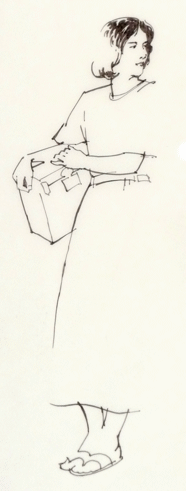
You allow yourself to use more of your creativity and imagination and...
...you make the viewer use his or her imagination, too.
That grabs the viewer’s attention and pulls them into your art.
Look at the drawing at left.
I made the woman's head the star of my drawing by putting my darkest darks - the most contrast - in her hair.
But look how much of her body I don't show you.
I'm leaving a lot to your imagination.
But, as long as everything I show you is the right size, the right shape and in the right place, you have no trouble seeing her as a complete human being.
That pulls you into the art.
It makes you examine the image more closely, because by not showing you every part of her body, I'm doing something you don't expect...
...thereby creating visual surprise.
And I’ve done similar things in this drawing below.
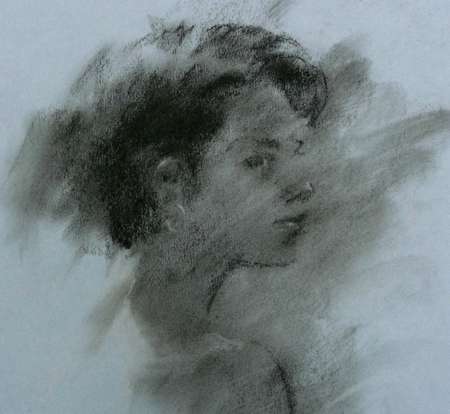
I didn’t show you every edge of her face. I didn’t draw lots of little lines to represent her hair.
I didn’t need to, because...
I knew... that you would know... exactly what everything was.
When you simplify, you can make your work more interesting rather than less.
Simplify, Simplify
Remember that what you leave out of a painting or drawing is just as important as what you put in.
In previous blog posts I showed you the artwork of Mark English, David Grove and Robert Heindel.
Their
paintings are good examples of how simplifying and creating simple
shapes can make a painting stronger and more interesting.
Now, I realize their work can be both inspiring and intimidating.
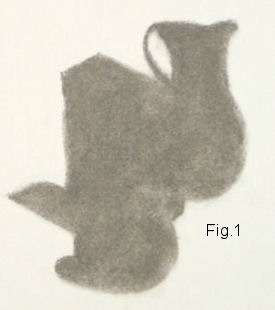
So in this blog post I'm going to simplify the concept of simplifying and show you a simple idea you can do at home.
The goal of this exercise is to draw or paint a few small objects with as little detail as possible...
...while still allowing the viewer to understand what they are.
The other criterion is to simplify in a way that is also interesting.
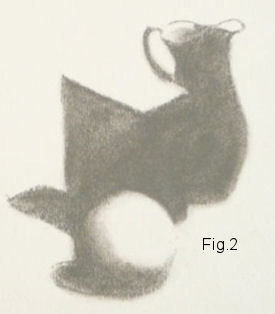
In Figure 1 are three objects.
Even though they are in silhouette, you can still probably guess at what these simple shapes are.
But, while these shapes are greatly simplified, they aren't very interesting yet.
I need to break up these shapes into an interesting arrangement of dark and light areas (values).
In Figure 2 I imagined the light coming from the right and above the objects, so I used that idea to create lighter areas where the highlights would be brightest.
Now these light areas break up the dark tone and make the shapes more interesting.
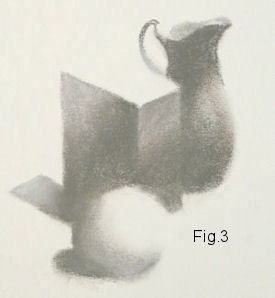
You can see how nicely the dark areas flow together to unite all the objects.
You don't really need to see all the edges of all the objects to know what they are.
While I now have interesting dark and light shapes, I can go just a little bit further to make this simple drawing idea more interesting.
In Fig. 3, rather than have one flat dark tone throughout the drawing, I can create a little variation in that tone.
The dark tone still flows through each of the objects and helps unite them, but now they've taken on more form.
They look more three-dimensional without going into much detail at all.
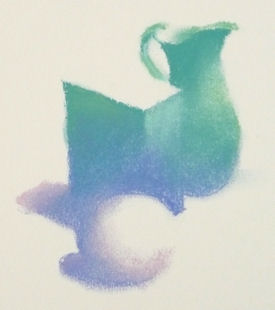
Once I've got these shapes simplified to the point that I've created interesting dark and light values...
I can use almost any harmonious colors I want to paint them, and it should work out just fine.
It's the interesting arrangement of dark and light values that usually matters most in a painting, not necessarily the color.
Or as artist Richard McKinley says, "Values do all the work and color gets all the credit."
So give this simple idea a try.
Best Wishes,
Gary Gumble
Founder of BeginningArtist.com
Without art the crudeness of reality would make the world unbearable. (George Bernard Shaw)
P.S. This is one way to learn how to add creativity and visual surprise to your work.
In
fact, I think the first person who will be surprised is you...
...when you learn how little you need to show to have an exciting drawing or painting.
P.P.S. Have a friend who would enjoy this article? Send it to them and invite them to join my blog. Click here to Subscribe.Copyright Gary Gumble 2023 All rights reserved About Privacy Policy Terms of Use Contact www.beginningartist.com 27 rue Roucher, 34000 Montpellier, France